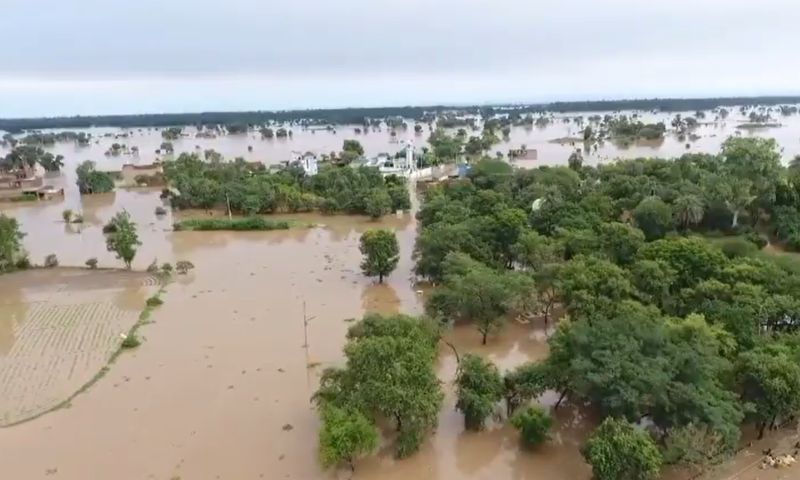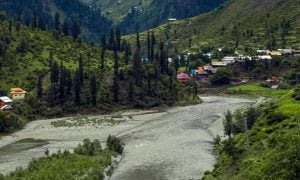Staff Reporter
- Rivers Chenab, Ravi and Sutlej reach “exceptionally high” flood levels
- Over 20,000 people evacuated so far from flood-hit areas
- Sialkot records 363.5mm of rain in 24 hours, breaking a 49-year rainfall record
ISLAMABAD: With Pakistan’s Punjab province battling a severe flood crisis caused by days of heavy rainfall and the release of water from two Indian dams, the provincial government has deployed the army to assist with rescue and relief efforts in six severely impacted districts.
What’s happening?
Early Wednesday, the Chenab, Ravi, and Sutlej rivers reached “exceptionally high” flood levels at multiple locations. Thousands of people living near the rivers are at risk, and many have already been moved to safer places.
This crisis began after India opened the floodgates of its Thein Dam on the Ravi River, just a day after warning that it would also release water from Madhopur Dam. These two rivers flow from Indian Punjab into Pakistan. At the same time, heavy rainfall in Pakistan’s northern regions made things worse.
Districts on high alert
According to the Flood Forecasting Division, Pakistan Meteorological Department (PMD), the most dangerous water levels were recorded at:
Chenab River: Qadirabad and Khanki headworks (with over 1 million cusecs of water at Khanki).
Ravi River: Jassar
Sutlej River: Ganda Singh Wala
Another key point, Marala Headworks, also saw a “very high” flood early in the morning.
Meanwhile, headworks on the Indus River – including Chashma, Taunsa, Guddu, Sukkur, and Kotri — are currently at “low” flood levels.
#PakistanWeather #PunjabRainAlert #KashmirWeather #HeavyRain #WeatherUpdate #FloodWarning #StaySafe #PakMetDept #RainstormAlert #ThunderstormWarning #WeatherAdvisory #MonsoonAlert pic.twitter.com/R9B6GteifF
— Pak Met Department محکمہ موسمیات (@pmdgov) August 27, 2025
Evacuations underway
The Provincial Disaster Management Authority (PDMA) has evacuated over 20,000 people from the floodplains of Chenab and Ravi so far. Authorities say that water levels in some places are reaching levels not seen in nearly 40 years.
“We’re expecting around 180,000 to 190,000 cusecs of water to pass through Shahdara tonight, but it should stay within the safe limit,” said PDMA Director General Irfan Ali Kathia.
Rescue teams from Rescue 1122 have already moved hundreds of people from villages and low-lying areas in Sialkot, especially from places like Nullah Palkhu, River Tawi, and Sambrial tehsil.
Army steps in
Due to the scale of the emergency, the army has been deployed to Lahore, Faisalabad, Kasur, Sialkot, Narowal and Okara.
فلڈ اپڈیٹ/ پنجاب pic.twitter.com/UYL6ia4OlN
— PTV News (@PTVNewsOfficial) August 27, 2025
Troops are working with local administrations to carry out rescue operations, move people to safety, and protect property from flood damage.
Government response
Prime Minister Shehbaz Sharif has ordered federal ministers to visit the affected areas and supervise relief efforts. He also asked the NDMA (National Disaster Management Authority) to work closely with Punjab officials and speed up evacuations.
وزیراعظم محمد شہباز شریف کا دریائے چناب، دریائے ستلج اور دریائے راوی میں شدید سیلاب کے خطرات کے پیش نظر وفاقی وزراء کو خصوصی ہدایات
وزیراعظم نے وفاقی وزراء کو صوبہ پنجاب کے سیلاب سے متاثرہ علاقوں کا فوری دورہ کرنے اور امدادی کارروائیوں کی نگرانی کرنے کی ہدایت کی۔
وزیرِ اعظم… pic.twitter.com/U60pJx2vQo
— Government of Pakistan (@GovtofPakistan) August 26, 2025
“There’s no room for mistakes,” said Punjab Relief Commissioner Nabeel Javed, calling for fast and careful evacuations.
The PDMA has also confirmed that, for now, they will not breach any river embankments — a drastic step that is sometimes taken to control the water’s path.
More rain expected
3/6 pic.twitter.com/otrwPErpxO
— Punjab Police Official (@OfficialDPRPP) August 27, 2025
The Pakistan Meteorological Department (PMD) has warned that more rain, wind, and thunderstorms are expected over the next few hours in Narowal, Sialkot, Lahore, Kasur, Jhelum, Gujranwala, Gujarat, and Azad Kashmir. They have advised people to stay alert and take precautions.
Sialkot breaks 49-year record
#SialkotRainfallRecord #HeavyRainfall #PakistanWeather #RainAlert #SialkotNews #ClimateUpdate #Monsoon2025 #WeatherBreakingNews #RecordRainfall #MetOfficePakistan pic.twitter.com/MzmVyPyD2L
— Pak Met Department محکمہ موسمیات (@pmdgov) August 27, 2025
In the past 24 hours, Sialkot received 363.5mm of rain – the most in nearly five decades. The last time the city saw such rain was in 1976, when it received 339.7mm in a single day.
























